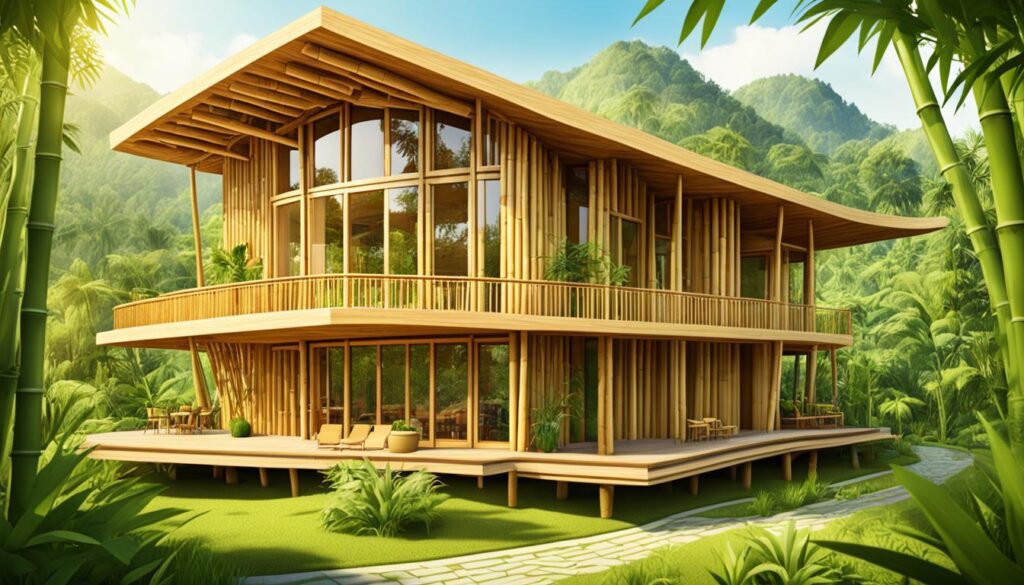O cenário atual de busca por soluções sustentáveis na indústria da construção tem destacado o bambu como uma alternativa promissora. Com propriedades únicas, como rápido crescimento e resistência, o bambu tem o potencial de reduzir os impactos ambientais na construção.
Como um dos recursos naturais mais antigos e versáteis, o bambu tem sido utilizado em diversas culturas ao longo da história. Sua taxa de crescimento notável, resistência e durabilidade o tornam um recurso renovável altamente promissor para atender às demandas da construção moderna, reduzindo os impactos ambientais associados aos métodos de construção convencionais.
Este artigo explorará o potencial do bambu na construção sustentável, analisando suas propriedades únicas e uma variedade de possíveis aplicações. Ele examinará o cultivo, a colheita, o tratamento e as práticas de construção do bambu, bem como os padrões regulatórios que regem seu uso, e destacará estudos de caso bem-sucedidos e projetos exemplares que demonstram o impacto positivo do bambu na construção sustentável.
O Potencial do Bambu na Construção Sustentável
Bamboo has emerged as a promising alternative in the quest for sustainable construction solutions. This versatile and rapidly renewable resource offers a range of unique properties and environmental benefits that make it an attractive choice for modern building practices.
Propriedades Únicas e Benefícios Ambientais
Bamboo is known for its remarkable strength, flexibility, and fast growth rate, making it a highly renewable material suitable for a variety of construction applications. Unlike traditional building materials, bamboo can be harvested without the need for replanting, as it regenerates from the same root system.
One of the most significant advantages of using bamboo in construction is its ability to capture and store carbon dioxide. As bamboo grows, it actively removes greenhouse gases from the atmosphere, contributing to the reduction of carbon emissions and promoting a more eco-friendly approach to building.
Additionally, bamboo is a highly biodegradable material, ensuring that its environmental impact is minimized even at the end of its lifecycle. This characteristic aligns with the principles of sustainable architecture and green building, making bamboo a valuable resource for environmentally conscious construction projects.

The unique properties of bamboo, coupled with its renewable nature and environmental benefits, make it a compelling choice for sustainable construction and a viable alternative to traditional building materials. As the demand for eco-friendly and sustainable architecture continues to grow, the potential of bamboo in the construction industry is poised to be a significant driving force in the pursuit of a more sustainable future.
Bambu
Bamboo has gained increasing recognition as a versatile and sustainable construction material. This renewable resource offers numerous advantages for those seeking an eco-friendly and low-impact home. Bamboo construction is highly durable and can be adapted to a wide range of architectural styles, from modern to rustic.
One of the key benefits of bamboo is its natural insulating properties, which provide thermal and acoustic comfort within the home. To ensure the longevity and performance of bamboo structures, proper treatment and regular maintenance are essential. Protective measures against pests and moisture, as well as the use of specialized oils and varnishes, help to maintain the integrity and durability of bamboo.
Bamboo’s rapid growth, carbon sequestration capabilities, and biodegradable nature make it an increasingly attractive choice for sustainable living, contributing to the preservation of the environment. As a plant-based material, bamboo is considered an eco-friendly and renewable alternative to traditional construction materials, making it a popular choice for those committed to green living and reducing their environmental footprint.

Beyond its use in construction, bamboo has a wide range of applications in various industries, including furniture, decor, and textiles. Its natural fibers and sustainable qualities make it an increasingly sought-after material for eco-friendly products and organic materials.
“Bamboo is not only a beautiful and durable material, but it’s also a renewable resource that can help reduce our impact on the environment.”
As the demand for sustainable materials and environmentally conscious solutions continues to grow, bamboo stands out as a versatile and renewable resource that can contribute to the development of green living and plant-based materials. Its unique properties and environmental benefits make it an increasingly attractive choice for bamboo construction and a wide range of bamboo applications.
Conclusão
Em conclusão, o bambu se apresenta como um recurso versátil e sustentável que possui enorme potencial para a vida moderna. Com suas propriedades únicas, como rápido crescimento, alta resistência e flexibilidade, o bambu oferece uma alternativa promissora aos materiais de construção tradicionais, contribuindo para a redução dos impactos ambientais.
A exploração detalhada das características e aplicações do bambu neste artigo demonstrou sua viabilidade como um material ecologicamente eficiente para a indústria da construção, ajudando a atender a crescente demanda por soluções de construção sustentáveis. Ao abraçar o bambu como um recurso renovável, o setor de construção pode desempenhar um papel fundamental na promoção de práticas de construção mais conscientes, equilibrando preocupações sociais, econômicas e ambientais.
À medida que a consciência do potencial transformador do bambu na construção sustentável continua a crescer, esta notável planta está posicionada para se tornar uma escolha cada vez mais proeminente para aqueles que buscam construir um futuro mais sustentável e ecologicamente consciente.
FAQ
What are the unique properties of bamboo that make it a promising sustainable material for construction?
Bamboo is known for its rapid growth, high strength-to-weight ratio, and flexibility, making it a highly renewable and durable resource suitable for modern construction needs. Bamboo also has natural insulating properties and can effectively capture and store carbon dioxide, contributing to the reduction of greenhouse gas emissions.
How does bamboo cultivation and harvesting contribute to its sustainability?
Bamboo is a grass that can rapidly regenerate from the same root system without the need for replanting, making it a truly sustainable material. Additionally, bamboo’s fast growth rate allows for more frequent harvesting, further enhancing its sustainability and environmental benefits.
What are the key considerations for ensuring the longevity and performance of bamboo structures?
Proper treatment and regular maintenance are essential for the longevity and performance of bamboo structures. Protective measures against pests and moisture, as well as the use of specialized oils and varnishes, help to maintain the integrity and durability of bamboo construction.
How can bamboo contribute to sustainable living and the preservation of the environment?
Bamboo’s rapid growth, carbon sequestration capabilities, and biodegradable nature make it an increasingly attractive choice for sustainable living, helping to reduce the environmental impact of construction and contributing to the preservation of the environment.
What are some successful case studies or exemplary projects that demonstrate the positive impact of bamboo in sustainable construction?
The article explores various successful case studies and projects that showcase the positive impact of bamboo in sustainable construction, highlighting its versatility, durability, and environmental benefits in a range of architectural styles and applications.